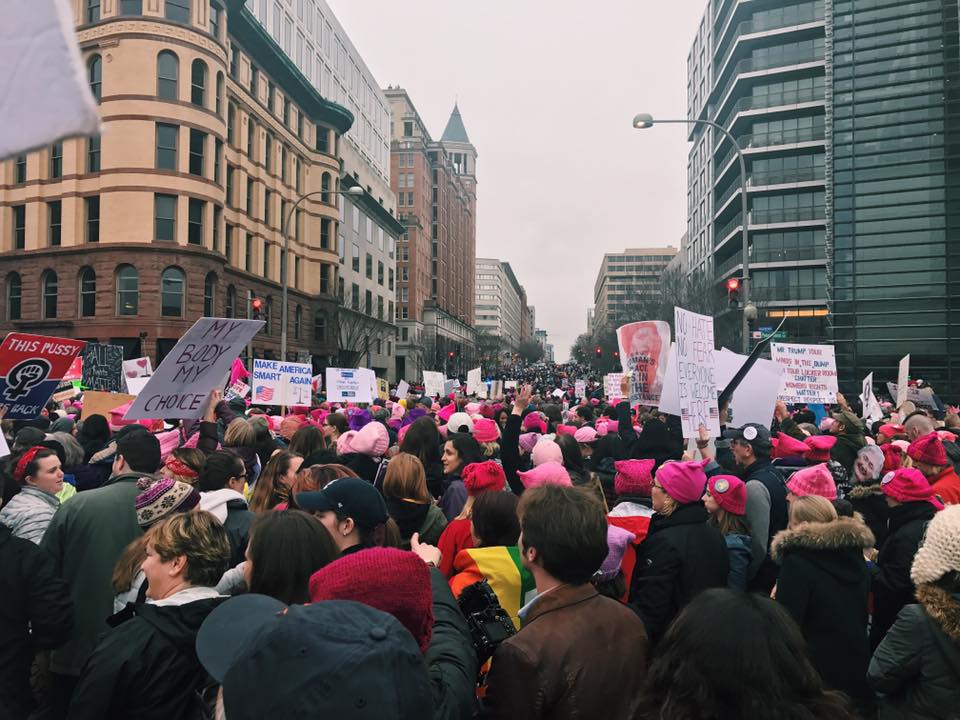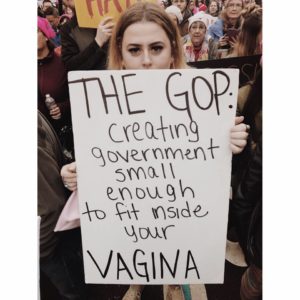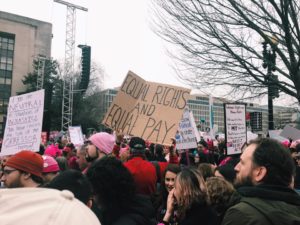CAMRY DEAN
Staff Writer

The day after Donald Trump was sworn in as the 45th President of the United States, millions of people came together. These people not only marched and protested his victory in Washington, D.C. but in solidarity all over the world.
On Jan. 21, I drove the seven hours from Fredonia to Washington, D.C. to join a million others in a sea of hot pink pussycat hats for the Women’s March on Washington.
With sister marches all over the United States, including in Buffalo and Rochester, the Women’s March on Washington was established almost immediately after Nov. 9, 2016 when Trump became our president-elect over former Secretary of State Hillary Clinton.
Women all over the country, as well as the world, felt Trump also had a long history of objectifying women with multiple accusations of sexual assault and harassment, as well as being heard bragging about his assaults in a 2005 recording with television host Billy Bush.

Former Gov. of Indiana, Mike Pence, who is now vice president, is what most marchers called “anti-women” for his controversial anti-abortion laws as governor. Indiana State Legislature introduced House Bill 1337, which, if passed, would have forced women to hold burials for their fetus, whether they had an abortion or they naturally miscarried. Doctors who performed these abortions could also be sued for “wrongful death.”
The march also stood in support of Planned Parenthood, which has been under constant attack by Republicans due to the fact that the organization performs abortions. The organization offers low-cost reproductive health and preventative care for both men and women, and absolutely no federal funds are used on abortions, which make up about 3 percent of what Planned Parenthood offers, despite right-wing efforts to discredit them.
While the march did focus a lot of its attention on women’s rights and equality for women, I and many other groups stood in solidarity against the Trump administration.
Pence also has a very long history of being anti-LGBTQ while advocating against anti-discrimination laws and same-sex marriage. Pence also believes in conversation therapy, or the discredited method to “change” one’s sexual orientation. The practice is often deemed inhumane. Along with this, Pence stated in 2000 that he believed the funding for the Ryan White Care Act, which provides federal funding for HIV and AIDS patients should be used for conversation therapy, which isn’t supported by any major mental health professionals or organizations.
His victory, which came as a surprise to most, left other minorities and marginalized groups feeling unsafe due to his comments on Mexican immigrants, the Islamic faith and refugees, and individuals with disabilities during his campaign.

Trump ran his campaign on the idea of “building a wall” between Mexico and the United States to try and combat illegal immigration, promising Mexico would pay for it, after calling Mexican immigrants “criminals and rapists.”
The then-proposed wall was set in action by Executive Order on Jan. 25, with American taxpayers now footing the bill.
Trump has also proposed publishing a list of crimes committed by undocumented individuals. He also ran the idea of a “Muslim ban,” which would keep Muslim refugees fleeing danger from coming to the United States in hope of preventing domestic terrorism, although according to the Triangle Center on Terrorism and Homeland Security, terrorism by radicals makes up one-third of 1 percent of deaths in the United States. This idea was also signed by Executive Order on Jan. 27, the same day Pence attended the March for Life in D.C. The very controversial ban was made even more controversial when Trump failed to ban refugees from Saudi Arabia, Egypt and Turkey — countries Trump has business relations in. The ban has also been affecting green card holders and dual citizens.
Scientists, indigenous groups and those who believe in climate change also marched against Trump and his administration’s views on science. Since the march, the once-halted Dakota Access Pipeline was again signed into action by Executive Order on Jan. 24. Trump also tweeted in 2012 that climate change was “made up by China” and has appointed climate change deniers to his cabinet. In addition, Trump has also silenced the Environmental Protection Agency and has frozen all new grants.
Because of all of these issues, people marched on all seven continents, including Antarctica. While many say the march was a success and the start of a resistance against the Trump administration, not everyone felt the same way.
When I returned home to Fredonia, still buzzing from being a part of something so incredible, I checked social media to see nothing but negativity. Women all over the United States voiced their concerns for women in the East and how they felt seeing millions of women march for basic human rights and equality in the West while simultaneously ignoring Trump’s anti-immigrant and Muslim rhetoric. I also saw women complain that we are just as equal as men while ignoring the wage gap, attacks on reproductive rights, slut-shaming and victim blaming, and all-around double standards. Whether they want to discredit the movement or not, feminism is still working for them.
While these conversations left me feeling uneasy, there were complaints coming from other groups that affected me more.
Women of color, specifically black women, felt they still weren’t being heard, despite the attempted intersectionality of the marches. I saw a picture of a man holding a poster that read “I’m going to see all of you nice white ladies at the next Black Lives Matter march, right?” and I realized, despite my own Black Lives Matter poster that I was sporting at the march and being surrounded by all of the women fighting for their reproductive rights, that feeling scared for the first time in 2016 was a privilege.
Tamika D. Mallory, national co-chair for the march and activist and advocate for civil rights issues, equal rights for women and police misconduct, said during her speech that black women have always been scared and that black women have always been fighting, especially when feminism focused solely on the rights of white women.
Trump has always been controversial when it has come to race. He was sued by the federal government for housing discrimination, the comments he’s made about the Black Lives Matter movement and police brutality. He was also at the forefront of the “birther movement,” which claimed former President Barack Obama was born in Kenya, claims based solely on the color of his skin.
I also saw people praising the fact that there weren’t any arrests at the marches to further discredit the Black Lives Matter movement, but I have reason to believe that this was because it was a planned event with the majority of marchers being white women.
I believe that if your feminism isn’t intersectional, then it’s only damaging. Despite my own efforts to be as inclusive as possible, the march only reassured me that I have to continue to do better. I’m grateful to have stood with so many people and activists such as Angela Davis, Janet Mock, Carmen Perez, Linda Sarsour and Gloria Steinem, but I’m also grateful it reminded me of my privilege and that white women have to continue being there for women of color.
